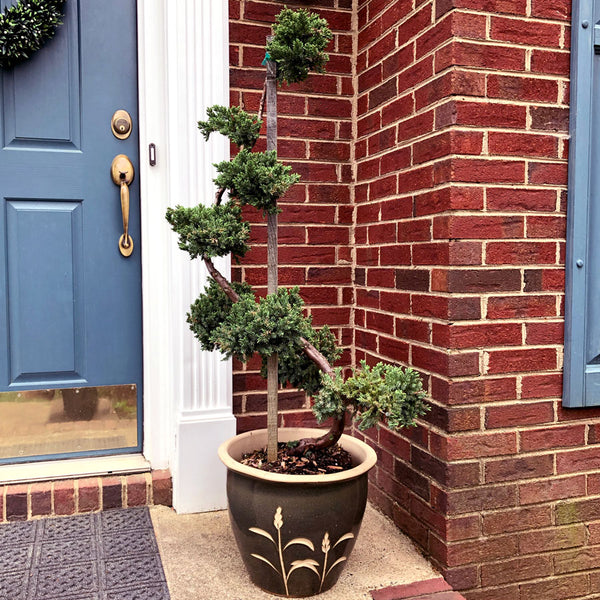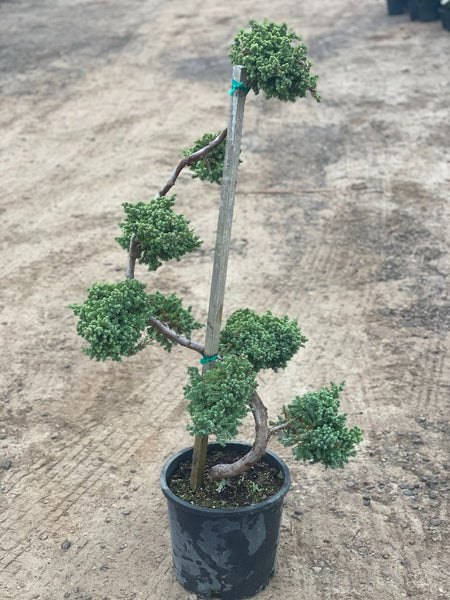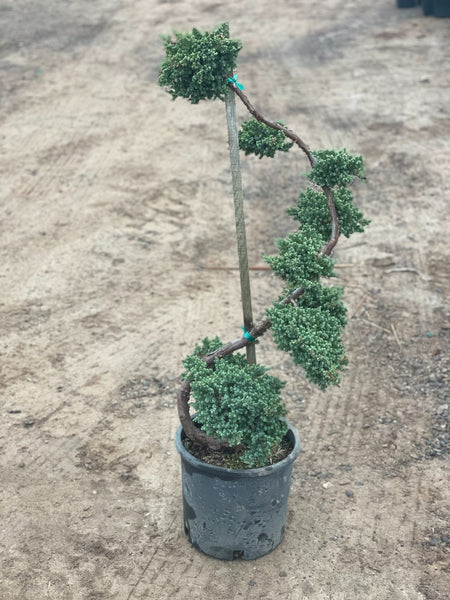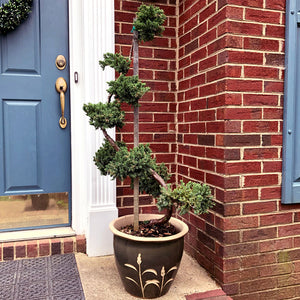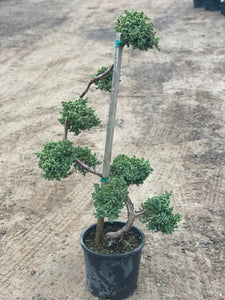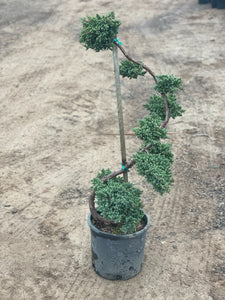Dwarf Japanese Garden Juniper Topiary
Dwarf Japanese Garden Juniper Topiary
A beautiful addition to any size garden or patio.
- The Dwarf Japanese Garden Juniper Tree Topiary is a highly adaptable and low maintenance shrub
- This topiary is a winter hardy, drought resistant shrub that grows best in zones 4-9
- Japanese Juniper Topiaries will elevate your yard with the exceptionally pruned designs
- The blue-green foliage pairs well with plants like Dwarf Bamboo, Dwarf Sea Holly, Blue Zinger Sedge, and Husker Red Penstemon


Product Details
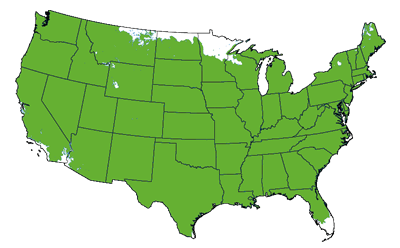 Growing Zones 4-9
Growing Zones 4-9
| Soil Type | Well Drained |
| Sunlight | Full, Partial |
| Drought Tolerance | Good |
| Mature Height | 4-5 Feet |
| Mature Width | 4-5 Feet |
| Growth Rate | Slow |
| Shipping Restriction | AZ, CA |
The Dwarf Japanese Garden Juniper Tree topiary will add a new dimension to any landscape. Most commonly recognized as a ground cover shrub, these natives to southern Japan are intentionally grown into living works of art.
Juniper topiaries make elegant additions to any driveway, stoop, or landscape. These beautifully sculpted topiaries only grow to a height of 4 feet, which makes them an ideal addition to even the smallest spaces.
Does the Japanese Garden Juniper Tree require a lot of water?
These evergreens are drought tolerant and prefer a soil that is on the drier side.
Do Junipers have deep roots?
The root system may grow upwards of 2 to 3 feet, however the roots responsible for getting all the nutrients only grow to about 12 to 18 inches.
How long do Dwarf Garden Junipers live?
A Dwarf Garden Juniper Tree can be expected to live for about 50 years as long as they are properly maintained.
Plant these sun-loving topiaries in a well draining soil. The elegant blue-green foliage prefers at least 6 hours of direct sunlight. The Japanese Dwarf Garden Juniper is a slow-growing shrub which is strategically pruned into eye catching designs. A general all-purpose, and water soluble fertilizer should be applied on a monthly basis to ensure proper nutrition.
Planting
These rustic beauties can be planted as a single stand alone shrub, or they can be planted alongside other Dwarf Junipers to create a border or break in your landscape design.
These well-groomed miniature shrubs should be planted in a hole that is double the width of the root ball, but only as deep as the container that it was purchased in. Once the topiary has been removed from the nursery container, you should gently loosen the roots. Do this prior to transferring it to a new container or planting it in the ground.
If container planting is a better suited solution for your space availability, keep in mind that as the Dwarf Japanese Garden Juniper grows the container must also grow. At a maximum height of 4 foot, the housing container for a Dwarf Japanese Juniper should be about 1 ½ feet tall to accommodate the root system of these marvelous shrubs. Additional drainage holes and landscape fabric should be added to any containers which will help ensure proper drainage and optimal growth.
The sturdy foliage is ideal for survival in climate zones 4-9.
Watering
While these well-sculpted masterpieces are drought tolerant they prefer to have moist well-draining soil. Take special care to not over water the Dwarf Japanese Garden Juniper Tree as this can lead to root rot. Container-housed topiaries may require additional waterings to keep them lush and vibrant.
Fertilizing
A very general 10-10-10 fertilizer mix should be applied on a monthly basis to provide sufficient nutrients to this decorative Japanese topiary. There is an organic fertilizer option which consists of mixing mulch with organic compost and spreading it throughout the root zone.
Maintenance
Pruning each spring is imperative to keeping the well manicured shape of this mature Garden Juniper. Any dead or diseased branches should be removed as needed. Dwarf Japanese Garden Junipers do best when they are pruned in early spring. Since these topiaries have been diligently pruned into shape, light pruning is sufficient to maintain the shape and desired height. Hand-held topiary shears are ideal to achieve the uniformity of the previously established shape.



